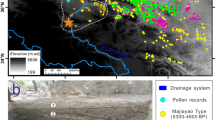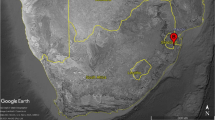Abstract
Charcoal analysis is a useful tool to gather information about the diversity of vegetation as well as human behaviour towards the environment and the diversified management of natural plant resources. Here we present the taxonomic identification of charcoal and calculate the percentage of each diameter class of the pieces excavated from the Shannashuzha archaeological site, Gansu Province. We discuss the implications of the data for the composition of the past woodland vegetation and prehistoric human fuel collection strategy. Twenty-two taxa were identified from 2,241 charcoal fragments with a further 50 fragments unidentified. Picea, Pinus, Bambusoideae, Salix, Populus, Quercus and Betula were abundant in many samples, although Bambusoideae is probably over-represented due to its high chance of being preserved. The vegetation around the Shannashuzha site had a typical mountain character and the main vegetation types reflected by the charcoal records included conifer woods, mixed broadleaved/conifer woods and riverbank broadleaved woods. This vegetation is similar to the modern vegetation and therefore the climate at that time is deemed to have been similar to or slightly warmer than today. Abundance was probably an important factor in the fuel collection strategy of the people. Collection of wood with a small diameter was a purposeful choice by prehistoric people, probably because it was less time-consuming in the study area, which was rich in wood resources. We conclude that in this region, prehistoric people selected firewood depending not on its type, but rather on its size (diameter). Charcoal from fruit trees found at this site and at many others nearby indicates that there was a common and long history of fruit utilization by prehistoric people in the western Loess Plateau. These results provide valuable information and a new insight into the interaction between human activities and plant resources in the Neolithic period.


Similar content being viewed by others
References
An CB, Ji DX, Chen FH, Dong GH, Wang H, Dong WM, Zhao XY (2010) Evolution of prehistoric agriculture in central Gansu Province, China: a case study in Qin’an and Li County. Chin Sci Bull 55:1,925–1,930
An CB, Li H, Dong WM, Chen YF, Zhao YT, Shi C (2014) How prehistoric humans use plant resources to adapt to environment: a case study in the western Chinese Loess Plateau during Qijia period. Holocene 24:512–517
Asouti E, Austin P (2005) Reconstructing woodland vegetation and its exploitation by past societies, based on the analysis and interpretation of archaeological wood charcoal macro-fossils. Environ Archaeol 10:1–18
Asouti E, Kabukcu C (2014) Holocene semi-arid oak woodlands in the Irano-Anatolian region of Southwest Asia: natural or anthropogenic? Quat Sci Rev 90:158–182
Aurélie S, Dufraisse A (2014) Understanding the impact of socio-economic activities on archaeological charcoal assemblages in temperate areas: a comparative analysis of firewood management in two Neolithic societies in Western Europe (Belgium, France). J Anthropol Archaeol 35:153–163
Bureau of National Cultural Relics (2011) Atlas of Chinese Cultural Relics—Fascicule of Gansu Province. Surveying and Mapping Press, Beijing
Chen JQ, Yang JJ, Peng Liu (1992) China Timber Atlas. China Forest Publishing House, Beijing
Cui HT, Li YY, Hu JM, Yao XS, Li Y (2002) Vegetation reconstruction of Bronze Age by using microscopic structure of charcoals. Chin Sci Bull 47:2,014–2,017
Dong GH, Wang L, Cui YF, Elston R, Chen FH (2013) The spatio-temporal pattern of the Majiayao cultural evolution and its relation to climate change and variety of subsistence strategy during late Neolithic period in Gansu and Qinghai Provinces, northwest China. Quat Int 316:155–161
Dong WM, An CB, Fan WJ, Li H, Zhao XY (2016) Stable isotopic detection of manual intervention among the faunal assemblage from a Majiayao site in NW China. Radiocarbon 58:311–321. doi:10.1017/RDC.2015.6
Dufraisse A (2006) Charcoal anatomy potential, wood diameter and radial growth. In: Dufraisse A (ed) Charcoal analysis: new analytical tools and methods for archaeology. BAR Internat Ser 1483, Archaeopress, Oxford, pp 47–60
Dufraisse A (2008) Firewood management and woodland exploitation during the late Neolithic at Lac de Chalain (Jura, France). Veget Hist Archaeobot 17:199–210
Dufraisse A (2012) Fire wood and woodland management in their social, economic and ecological dimensions. New perspectives. In: Badal E, Carrión Y, Macías M, Ntinou M (eds) Wood and charcoal: evidence for human and natural history. SAGVNTVM EXTRA-13, Valencia, pp 65–73
Figueiral I, Mosbrugger V (2000) A review of charcoal analysis as a tool for assessing Quaternary and Tertiary environments: achievements and limits. Palaeogeogr Palaeoclimatol Palaeoecol 164:397–407
Godwin H, Tansley AG (1941) Prehistoric charcoals as evidence of former vegetation, soil and climate. J Ecol 19:117–126
He F, Wang DX, Zhang SZ, Liu WZ, Shen YZ, Hu YN (2011) Reserves of litter and woody debris of two main forests in the Xiaolong Mountains, Gansu, China. Chin J Appl Environ Biol 17:46–50
Hu ZY (2015) Research of charred botanical remains from Shannashuzha Site in Gansu Province. Dissertation, Xibei University
Huang D (1997) Gansu vegetation. Gansu Science and Technology Press, Lanzhou, pp 178–180
Institute of Archaeology, Chinese Academy of Social Sciences (2010) Chinese archaeology: neolithic. Chinese Social Sciences Press, Beijing
Jia X, Dong GH, Li H, Brunson K, Chen FH, Ma MM, Wang H, An CB, Zhang KR (2013) The development of agriculture and its impact on cultural expansion during the late Neolithic in the Western Loess Plateau, China. Holocene 23:85–92
Keepax CA (1988) Charcoal analysis with particular reference to archaeological sites in Britain. Dissertation, University of London
Li SC (2009) Westward spread of Eastern: the process of prehistoric culture in northwest of China. Cultural Relics Press, Beijing
Li XQ, Sun N, Dodson J, Zhou XY (2012) Human activity and its impact on the landscape at the Xishanping site in the western Loess Plateau during 4,800-4,300 cal yr bp based on the fossil charcoal record. J Archaeol Sci 39:3,141–3,147
Li XQ, Sun N, Dodson J, Zhou XY, Zhao KL (2013) Vegetation characteristics in the western Loess plateau between 5200 and 4300 cal bp based on fossil charcoal records. Veget Hist Archaeobot 22:61–70
Li H, An CB, Dong WM, Wang SZ, Dong GH (2014) The charcoal records of Qijia site in Longdong Basin and its significance. Quat Sci 34:35–42
Liu GX, Shi YF, Shen YP, Hong M (1997) Holocence megathermal environment in the Tibetan Plateau. J Glaciol Geocryol 19:114–123
Ludemann T (2006) Anthracological analysis of recent charcoal-burning in the Black Forest, SW Germany. In: Dufraisse A (ed) Charcoal analysis: new analytical tools and methods for archaeology. BAR Internat Ser 1483, Archaeopress, Oxford, pp 61–70
O’Carroll E, Mitchell FJG (2012) Charcoal samples guidelines: new methodological approaches towards the quantification and identification of charcoal samples retrieved from archaeological sites. In: Badal E, Carrión Y, Macías M, Ntinou M (eds) Wood and charcoal: Evidence for human and natural history. SAGVNTVM EXTRA-13, Valencia, pp 275–281
Pei WZ (1987) Archeaological Investigation of Gansu Corridor and Qinghai Region, Northwest China. Cultural Relics Press, Beijing
Qin L, Fuller DQ, Zhang H (2010) Modelling wild food resource catchments amongst early farmers: case studies from the lower Yangtze and central China. Quat Sci 30:245–261
Reimer PJ, Bard E, Bayliss A et al (2013) IntCal13 and Marine13 radiocarbon age calibration curves, 0–50,000 years cal bp. Radiocarbon 55:1,869–1,887
Renfrew C, Bahn P (1991) Archaeology theories, methods and practice. Thames and Hudson, London
Salisbury KJ, Jane FW (1940) Charcoals from Maiden Castle and their significance in relation to the vegetation and climatic conditions in prehistoric times. J Ecol 28:310–325
Scheel-Ybert R (2002) Evaluation of sample reliability in extant and fossil assemblages. In: Thiébault S (ed) Charcoal analysis: methodological approaches, palaeoecological results and wood uses. BAR Internat Ser 1063, Archaeopress, Oxford, pp 9–16
Shackleton CM, Prins F (1992) Charcoal analysis and the “Principle of Least Effort”—a conceptual model. J Archaeol Sci 19:631–637
Shi YF, Kong ZC (1992) The climates and environments of Holocene megathermal in China. China Ocean Press, Beijing
Théry-Parisot I, Chabal L, Chrzavzez J (2010) Anthracology and taphonomy, from wood gathering to charcoal analysis. A review of the taphonomic processes modifying charcoal assemblages, in archaeological contexts. Palaeogeogr Palaeoclimatol Palaeoecol 291:142–153
Wang SZ, Li H, Zhang LR, Chen GK, Wang P, Zhao ZJ (2014) Tree exploitation and palaeo-environment at Heishuiguo Xichengyi site, Zhangye city, Gansu province—revealed with excavated charcoal analysis. Quat Sci 34:43–50
Xie DJ (2002) Prehistoric archaeology of Gansu Province and Qinghai Province. Cultural Relics Press, Bejing
Yan WM (1989) Research of Yangshao Culture. Science Publishing House Press, Beijing
Yang YM (1983) The brief report of Neolithic site investigation at Minxian, Gansu province. Archaeol Cult Relics 5:20–23
Yao X (1988) Structure of main Chinese wood. China Forest Publishing House, Beijing
Yuan J, Cai J, Hou L, Zhang SX (2012) Storage and decomposition of fallen wood in a Pinus tabulaeformis secondary forest at Huoditang Forest Region in the Qinling Mountains. Sci Silv Sin 48:141–146
Acknowledgments
This work was funded by National Key Technology R&D Program of China (Grant No. 2013BAK08B02) and National Natural Science Foundation of China (Grant No. 41071051).
Author information
Authors and Affiliations
Corresponding author
Additional information
Communicated by Y. Zhao.
Electronic supplementary material
Below is the link to the electronic supplementary material.
Rights and permissions
About this article
Cite this article
Li, H., An, CB., Dong, W. et al. Woodland vegetation composition and prehistoric human fuel collection strategy at the Shannashuzha site, Gansu Province, northwest China, during the middle Holocene. Veget Hist Archaeobot 26, 213–221 (2017). https://doi.org/10.1007/s00334-016-0585-8
Received:
Accepted:
Published:
Issue Date:
DOI: https://doi.org/10.1007/s00334-016-0585-8




